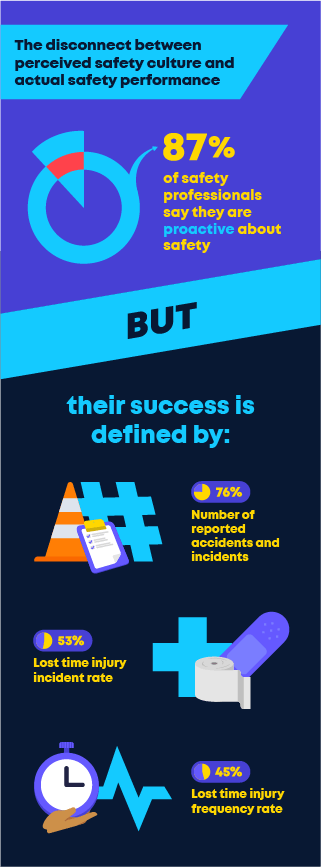Are safety professionals preparing for incidents to happen instead of preventing them?
Industry Trends | By | 16 Mar 2020 | 2 minute read

87 percent of safety professionals say they’re proactive about safety despite having failure-focused key performance indicators.
According to our global safety industry survey, success as safety professionals is primarily measured by lagging indicators, or the occurrence and frequency of events that happened in the past, such as:
- Number of Reported Accidents & Incidents (76 percent)
- Lost Time Injury Incidence Rate (53 percent)
- Lost Time Injury Frequency Rate (45 percent)
This reality was experienced by 50 percent of safety professionals in the construction industry, followed by 15 percent of those in manufacturing.
Other findings from our survey include:
- 21 percent of safety professionals overlook risks in order to get the job done
- 35 percent of percent safety professionals find it most difficult to engage employees with safety culture
- 87 percent of safety professionals perceive unsafe behavior to be the more likely cause of incidents
Lack of training may explain why corporate executives have a lower level appreciation for leading indicators, or measuring events leading up to incidents like the number of risks controlled and the average time to solve issues, which can be more accurately assessed through a comprehensive survey form. Otherwise, these proactive measures should have been the key performance indicators of safety professionals today.

According to QHSE Director Gary Bonnett, the disconnect between perceived safety culture and actual safety performance can exist if safety professionals are not exhibiting visible felt safety leadership—you can’t be a “desk mammal” and believe your culture is proactive.
He shared, “We weren’t getting anywhere with what we were measuring and had to make the investment of our time and resources to be proactive. This meant being in the field and in the shops and having crucial conversations with a mentoring and training mindset. When we showed them we were in this with them, the conversations and communication changed in a positive way.”
If you measure success by controlling previous numbers, then you are preparing to react to incidents instead of preventing them from happening. What proactive measures should you start to track today?
To view more insightful data, here is the link to the complete report: Safety Professionals Survey
Important Notice
The information contained in this article is general in nature and you should consider whether the information is appropriate to your specific needs. Legal and other matters referred to in this article are based on our interpretation of laws existing at the time and should not be relied on in place of professional advice. We are not responsible for the content of any site owned by a third party that may be linked to this article. SafetyCulture disclaims all liability (except for any liability which by law cannot be excluded) for any error, inaccuracy, or omission from the information contained in this article, any site linked to this article, and any loss or damage suffered by any person directly or indirectly through relying on this information.





